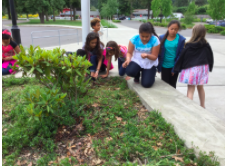The Nisqually River Education Project, South Sound GREEN and Chehalis Basin Education Consortium are offering the first ever Climate Resiliency Fellows. This program aims to build a dynamic community of engaged teachers committed to engaging their students in learning about and taking action in local climate change issues and climate resiliency projects. The Fellows program is offered as a part of a 3 year, environmental literacy program supported by NOAA. Teachers in the program meet quarterly to receive curriculum support and brainstorm ideas for action projects that address local issues. Becky Hendrickson is a teacher at Shining Mountain Elementary and one of our Fellows participating this year. Here, she shares her class’ experience releasing salmon they raised in their very own classroom and hosting a family science night! Thank you, Becky, for your dedication and enthusiasm for environmental education!
Last fall I started an After School Science Club with the assistance of a colleague to introduce the general education population to water quality monitoring. 7 Students collected water quality data from Tanwax Creek and presented their findings at Green Congress. Students were sad to see our meetings come to an end so I promised to resume the club in April.
Our club resumed in April with 22 students participating. I collaborated with Ryan Misley from Pierce County Public Works and Utilities. We began our environmental learning journey with a sit spot activity. Students were instructed to sit absolutely quiet and make notes in a journal describing what they see, smell, hear, and feel. We planned on having students sit for 10 – 15 minutes. Much to our surprise they sat for almost 30 minutes and were reluctant to move on. Over the course of 7 weeks, students completed worm studies in our compost bin, pulled invasive weeds from a school garden, and distributed seed balls to replant.
Our club also decided to start the process for becoming a Green School. We focused on the School Grounds category. I am in the process of writing up our work and submitting it.
Next year students want to continue our work. I plan on incorporating a waste audit and having students brainstorm ideas to decrease waste going to the landfill. This activity will help our school continue in its’ quest to become a green school. The activity will also meet standard for the Cool School Challenge. Looking ahead to next year, I would also like to incorporate some engineering activities for the after school science club. Engineering is Elementary offers free curriculum, two of the units have environmental themes (invasive species and recycled racers). I’m looking for a grant to purchase materials/supplies for the units.
Just One Thing
At our last Climate Fellows meeting, we discussed doing just one thing. I thought Project Budburst was the perfect activity for my class to do in honor of Earth Day. The Friday preceding Earth Day, I took my students out to the rain garden.Each student adopted a plant/tree. Students took ownership of the tree/plant by attaching a label with their name.
Now is where the “Just One Thing” really comes into play. Once students had chosen their tree/plant, I discovered that I was too overwhelmed to try and identify each of the trees/plants and report the information to the website. At first I was very disappointed in myself, but then I decided to give myself a break. My students took the first step in this project. As a special education teacher, most of my students will loop with me next year. Hopefully, this summer I will become rejuvenated, have the time to identify the plants, and be ready to start reporting data next year. While students were selecting their tree/plant, I took their picture. I plan on having students check on their tree/plant once a month so they can keep a journal (kind of a year in the life of ________). In the mean time, my students
had a wonderful time exploring the rain garden, picking up trash, and reflecting on the importance of Earth Day.


